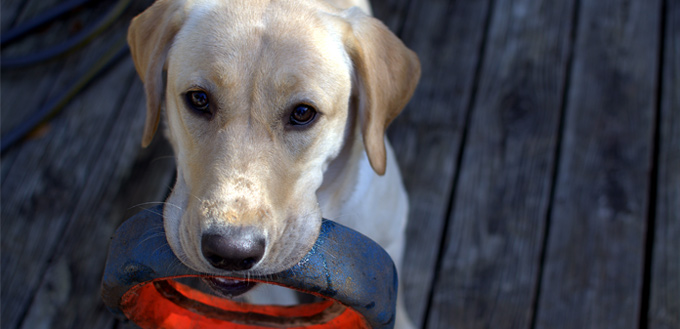Labradors are instantly recognizable, even to those who do not consider themselves to be “dog people”. Solid and sturdy, they have an almost square appearance, with sturdy legs and a strong body. Although they are technically “medium sized”, their sturdiness makes them appear bigger than they really are.
This breed is recognizable due to its drop ears, big expressive eyes and broad head. They have thick but short double coats which repel water and an “otter tail” which is sturdy, thick and virtually straight. They have webbed feet due to their swimming heritage. They come in several colours from a pale white/yellow through chocolate and black.

Labradors reach their adult height in around 6-12 months, but carry on filling out until they are around two. They tend to live for around 12-14 years.
The Labrador is one of the most popular dogs around the world thanks to its reputation for having a sweet nature, high intelligence and an eagerness to please its owner. As a large breed, Labradors need a high level of both mental and physical activity to stay happy, and while all are highly energetic and exuberant there is a great range of variation in personality traits between different animals.
Quick Facts
- Labradors love to eat and can easily become obese, so they need a lot of exercise and measured, regular meals. (Psst: Check out our review of the best dog food for labradors.)
- This breed needs a minimum of 30-60 minutes of exercise every day otherwise they have a tendency to have destructive behaviour patterns
- Labradors need training to learn good manners
- While many Labradors will slow down a little as they age, they generally remain pretty active through their whole lives
- Male Labradors usually measure around 22.5”-24.5” and weigh around 65-80 lbs. Females measure around 21.5”-23.5” and weigh around 55-70 lbs
- Labradors have a two-layered coat and shed a lot. They require daily brushing to remove loose hairs
Temperament
Labradors are usually very playful throughout their lives and have a reputation for being bouncy and clumsy, especially when they are puppies and young dogs. Although temperaments vary between different animals, in general Labradors are happy, friendly, loveable and loyal. They are highly energetic and have often earned the title of “man’s best friend”.
This breed is well known for being an excellent family dog (as long as it has received the right training) and is good with children and other animals. However, if they are left alone and allowed to become bored they can chew and damage furniture and items around the home. Labradors do have protective tendencies towards their home and family, however they are usually happy to welcome others into their territory too being a naturally friendly breed.
They love all kinds of activities including swimming, playing fetch, hiking and running and are an especially good choice for families with children since they love the commotion that young children bring and will happily join in with rough and tumble play. With the right training, Labradors will also be very obedient and well-behaved, however without appropriate training they could exhibit destructive tendencies.
Your lab will definitely enjoy swimming
Things You Should Know
If you are considering getting a Labrador, there are a number of useful things that you should know regarding the breed.
- Trainability: Labradors are very easy to train. They love to please their human owners and are keen to be rewarded with treats and affection. Although some owners do find them quite challenging to cope with due to their high energy levels, if they are trained from an early age with fun and interesting training, they will be good, well-behaved pets. Labradors enjoy play and when training is presented in the form of a game, they are happy to participate. However, if a Labrador does not receive adequate training at an early age, they may become too large and difficult to handle. Patience is also the key to dealing with a Labrador since they exhibit puppy-like behaviour well into adulthood. Bounciness is a characteristic of the breed, so commands like “stay” and “down” must be taught at an early stage. Once a Labrador has mastered the basic obedience skills, they are well suited to moving on to agility activities and advanced training since they love to spend time with their humans and with other animals.
- Behavioural traits: mouthing and chewing is a frequent problem with Labradors so having plenty of bones and chew toys to hand will help to protect furnishings and other items. Plenty of exercise is essential to keeping a Labrador occupied and non-destructive. This breed is also notoriously clumsy and will often slide on wooden floors, bump into furniture and knock things over with their tail. This puppy-like behaviour will not diminish until the animal is well into adulthood and can be difficult to overcome.
- Special breed characteristics: as Labradors were originally bred to retrieve in the shooting field, they have some key breed characteristics. One of their primary features is that they have a very strong urge to carry and pick things up with their mouths and they can carry items carefully. They also have an impressive ability for tracking by scent. If you are considering getting a Labrador you need to be aware of whether or not the breed is a good fit for your lifestyle. A Labrador is a good choice for you if you are looking for a pet who is:
- Bouncy and enthusiastic
- Large
- Cheerful and happy
- Keen to get plenty of exercise and loves athletic activity
- Good tempered
- Dependable with people of all ages
- Able to get on with other animals
- Keen to please
- Responsive to training
A Labrador will not be a good fit for you if:
- You don’t want to have to exercise your pet a lot
- You don’t want to deal with a lot of jumping and rowdiness
- You are worried about chewing, mouthing your hand and carrying objects
- You don’t want to deal with a lot of shedding
History
Labradors have a long history, hailing from Newfoundland off Canada’s North Eastern coast. Once known as St John’s dogs, the breed were once helpers and companions to fisherman in the local area from the 1700s onwards. They worked with their owners to retrieve fish that had escaped from the hooks and then lived with the fisherman’s family.
While the heritage of the Labrador is unknown, there is a belief that the breed was interbred with Newfoundlands and some other local small water dogs. The breed was introduced to the UK as hunting retrievers during the early 1800s, with the second Earl of Malmesbury being an early owner of St John’s dogs in 1830. It was the 3rd Early of Malmesbury who first referred to the breed as Labradors.
By the 1880s, surprisingly the breed was virtually extinct, and it was only in England that the breed was saved. In their original home of Newfoundland, tax laws and government restrictions caused the breed to disappear.

The Labrador was recognized by the Kennel Club as a breed in 1903 with the American Kennel Club following suit a few years later in 1917. During the 1920s-1930s, British Labradors were brought to America to help establish the breed and its popularity really took off following the Second World War.
By the early 1990s the Labrador earned the title of most popular dog to be registered with the American Kennel Club and it has held this honour ever since. It is also top of the list in England and Canada. They work in detecting explosives and drugs as well as in search and rescue, helping disabled people and as therapy dogs as well as for their original purpose – retrieving for hunters.
Labradors also excel at all types of dog competition, including field, show, obedience and agility.





